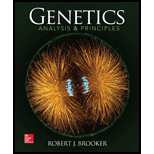
Concept explainers
To analyze:
On the basis of the given data of two codominant alleles of five human population:
A. The allele frequencies of 5 populations.
B. Identify populations included in Hardy-Weinberg equilibrium.
C. The populations that experienced significant intermixing because of migration.
Introduction:
Explanation of Solution
The data obtained from 5 human populations are as follows:
| Population | Place | MM | MN | NN |
| Inuit | East Greenland | 83.5 | 15.6 | 0.9 |
| Navajo Indians | New Mexico | 84.5 | 14.4 | 1.1 |
| Finns | Karajala | 45.7 | 43.1 | 11.2 |
| Russians | Moscow | 39.9 | 44.0 | 16.1 |
| Aborigines | Queensland | 2.4 | 30.4 | 67.2 |
The Hardy-Weinberg equation helps to calculate and determine genotype frequencies in large populations that meet the requirements of equilibrium. The equation of Hardy-Weinberg is:
For a gene with two possible alleles, the allelic frequency is represented by p and q. In this case, p is the M allele and q is the N allele. For the MM and NN genotypes, every individual has two identical alleles, so the allelic frequency for those members can just be carried over from the genotype frequencies. For the MN genotype, half the alleles will be M and half will be N, so it needs to be split in half for each allele and then added to the frequencies from MM and NN individuals. It can be represented as:
A. Here, in the question, there are five populations. The allele frequencies in five populations are as follows:
Population: Inuit
Place:East Greenland
Population: Navajo Indians
Place: New Mexico
Population: Finns
Place: Karajala
Population: Russians
Place: Moscow
Population: Aborigines
Place: Queensland
B. For the given circumstances in the question, a gene exists as two alleles: M and N. To determine if the given populations are in equilibrium, the Hardy-Weinberg equation can be used to calculate the number of individuals with each genotype.
Inuit:
Navajo Indians:
Finns:
Russians:
Aborigines:
In general, these values agree pretty well with the equilibrium. Thus, it can be said that all five populations are in Hardy-Weinberg equilibrium.
C. Hardy-Weinberg equilibrium is affected by several factors, which include genetic isolation, mutation, natural selection, and non-random mating. Migration or gene flow is also one of the factors that affect the Hardy-Weinberg equilibrium. It usually causes changes in the allele frequency and hence results in subtle deviations from the Hardy-Weinberg equilibrium. Based on similar allele frequencies, the Inuit and Navajo Indians appear to have interbred as well as the Finns and Russians.
Therefore, it can be concluded that,
A. The allelic frequencies of the five populations are:
Inuit: p = 0.913, q = 0.087
Navajo Indians: p = 0.917, q = 0.083
Finns: p = 0.6725, q = 0.3275
Russians: p = 0.619, q = 0.383
Aborigines: p = 0.176, q = 0.824
B. All the five populations are in Hardy-Weinberg equilibrium.
C. Inuit and Navajo Indian populations may have interbred, as well the Finns and Russians, due to the similarities in their allelic frequencies.
Want to see more full solutions like this?
Chapter 26 Solutions
Genetics: Analysis and Principles
- In one paragraph show how atoms and they're structure are related to the structure of dna and proteins. Talk about what atoms are. what they're made of, why chemical bonding is important to DNA?arrow_forwardWhat are the structure and properties of atoms and chemical bonds (especially how they relate to DNA and proteins).arrow_forwardThe Sentinel Cell: Nature’s Answer to Cancer?arrow_forward
- Molecular Biology Question You are working to characterize a novel protein in mice. Analysis shows that high levels of the primary transcript that codes for this protein are found in tissue from the brain, muscle, liver, and pancreas. However, an antibody that recognizes the C-terminal portion of the protein indicates that the protein is present in brain, muscle, and liver, but not in the pancreas. What is the most likely explanation for this result?arrow_forwardMolecular Biology Explain/discuss how “slow stop” and “quick/fast stop” mutants wereused to identify different protein involved in DNA replication in E. coli.arrow_forwardMolecular Biology Question A gene that codes for a protein was removed from a eukaryotic cell and inserted into a prokaryotic cell. Although the gene was successfully transcribed and translated, it produced a different protein than it produced in the eukaryotic cell. What is the most likely explanation?arrow_forward
- Molecular Biology LIST three characteristics of origins of replicationarrow_forwardMolecular Biology Question Please help. Thank you For E coli DNA polymerase III, give the structure and function of the b-clamp sub-complex. Describe how the structure of this sub-complex is important for it’s function.arrow_forwardMolecular Biology LIST three characteristics of DNA Polymerasesarrow_forward
 Human Heredity: Principles and Issues (MindTap Co...BiologyISBN:9781305251052Author:Michael CummingsPublisher:Cengage Learning
Human Heredity: Principles and Issues (MindTap Co...BiologyISBN:9781305251052Author:Michael CummingsPublisher:Cengage Learning Biology: The Dynamic Science (MindTap Course List)BiologyISBN:9781305389892Author:Peter J. Russell, Paul E. Hertz, Beverly McMillanPublisher:Cengage Learning
Biology: The Dynamic Science (MindTap Course List)BiologyISBN:9781305389892Author:Peter J. Russell, Paul E. Hertz, Beverly McMillanPublisher:Cengage Learning Biology (MindTap Course List)BiologyISBN:9781337392938Author:Eldra Solomon, Charles Martin, Diana W. Martin, Linda R. BergPublisher:Cengage Learning
Biology (MindTap Course List)BiologyISBN:9781337392938Author:Eldra Solomon, Charles Martin, Diana W. Martin, Linda R. BergPublisher:Cengage Learning Human Biology (MindTap Course List)BiologyISBN:9781305112100Author:Cecie Starr, Beverly McMillanPublisher:Cengage Learning
Human Biology (MindTap Course List)BiologyISBN:9781305112100Author:Cecie Starr, Beverly McMillanPublisher:Cengage Learning Concepts of BiologyBiologyISBN:9781938168116Author:Samantha Fowler, Rebecca Roush, James WisePublisher:OpenStax College
Concepts of BiologyBiologyISBN:9781938168116Author:Samantha Fowler, Rebecca Roush, James WisePublisher:OpenStax College





